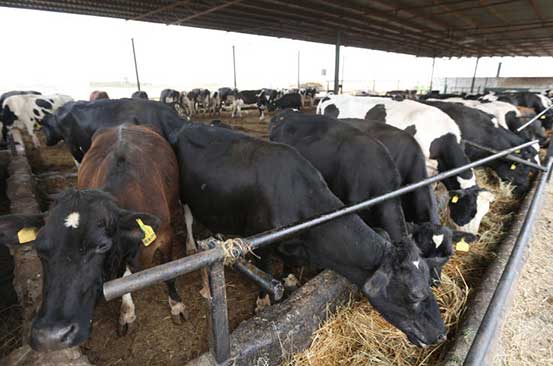At the heart of the dry and rocky Oloosirkon area in Ongata Rongai, Kajiado County, lies an evergreen modern dairy farm.
Started in 2009, Ole Ngishu Dairy Farm, has revolutionised dairy farming in the area with a herd of 100 dairy cows that comprise mostly of Friesians and a few Jersey and Ayrshire herds that produce 700 litres of milk daily.
The farm has an automated milking parlour with state-of-the-art machines that can milk 70 cows simultaneously in five minutes. The machines also record the amount of milk from each cow and transfer it to a cooling chiller where it can be stored for up to four days.
Kirtesh Shah, the owner of the dairy farm, says the milking parlour has a temperature of minus 3.9 degrees Celsius that makes it unfavourable for bacteria to survive.
Cows here are milked thrice daily. Each cow produces an average of 20 litres per day, milk that never lacks market as it is all supplied to Ice Cream Manufacturers in Nairobi.
Individuals and institutions visit Kirtesh’s farm to learn about dairy farming. The local community has also benefited from the farm which provides them with quality bulls for cross breeding purposes at a subsidised price.
But it has not been a walk in the park for Shah and setting up the capital-intensive dairy venture came at a hefty price. It took a lot of hard work, resilience and determination.
Quality semen
“We started out with three cows but were often encumbered by the prevalence of tse-tse flies that are common in this area. We had to spray the farm over a long period of time to protect the few cows we had at the time,” says Simon Songok, the farm manager.
Songok, an animal science graduate, says the farm sources its semen from Holland to upgrade and improve its breeds.
“Dairy farmers should ensure their cows do not get served by the scrub bulls, but get artificially inseminated by an expert inseminator with good quality semen of genetically meritorious bulls. To maintain the reproductive health of the breeding bulls, it is essential that they exercise regularly and get high profile feeds. They must also be screened regularly for contagious diseases,” he explains.
The strategy
Songok has planted maize, mangoes and kale in a small section of the land. A larger area is under Lucerne and Rhodes grass to supplement sigma feeds for the cows while approximately 30 acres is planted with maize for cattle feed. A small area is under mangoes and vegetables.
The abundance of feeds allows the cows to feed at regular intervals during the day. Since water is scarce in the area, four dams and a borehole have been sunk in the farm to provide a reliable supply of clean drinking water for the cows which must drink throughout the day.
“The feeds should be fresh, easily digestible, palatable, succulent and appetising. A strategic feeding programme should be observed before calving, mid lactation and in late lactation in order to achieve higher milk production levels,” Songok advices.
In Ole Ngishu Dairy Farm, nothing goes to waste. Waste water is directed at the lucerne and the rhodes grass fields through portable drip and overhead irrigation systems to maximise production.
“Nothing goes to waste in our farm. We spread manure from the cowshed in the fields and use waste water to grow grass and lucerne,” Songok says.
He says the secret behind successful dairy farming is a special dairy diet, which contains highly soluble feed grade monocalcium phosphate to give the cows adequate calcium and phosphorus for high milk production and fertility.
Additionally, the diet should provide optimum balance of energy and protein. Space requirements for animals of different age-groups is also paramount. Songok says adult cows, heifers and young calves should be separated.
“The height and width of the shed’s walls should be 1.5 metres by three metres. The shed should permit sufficient light without glare and the floor should be hard and impervious to water, non-slippery and easy to clean,” Songok says.
A circular water trough is centrally located in the shed. To maintain health, hygiene and sanitation, farmers should seek veterinary advice for treatment at an early stage of disease or to prevent spread of epidemics.
“Strict vigilance for cases of sore feet, milk fever, mastitis, bloat and impaction are essential. A farmer should follow good sanitation and disinfection programmes and there should be proper hygiene of herdsmen too. Thorough clean housing, mangers and water troughs are necessary to keep healthy herds and avoid occurrence of diseases. One should also follow vaccination schedules strictly to keep the calves free from ecto and endo-parasites and epidemics.”
High yielding
Having spent millions to come up with the project, Kirtesh says the proceeds are rewarding. Thriving from water harvesting methods, the farm is now a leading milk supplier and thrives from selling off bulls and heifers.
But what is his secret to such a healthy and high-yielding herd?
Good breeds, he says.
“Farmers should scrutinise an animal’s record before purchase. They should look out for history sheets and pedigree records and purchase freshly calved animals in their second or third lactation. They should ascertain actual milk yield by milking the animal three times consecutively. Farmers need to keep the newly-purchased animal under observation for a period of about two weeks before it is mixed with the general herd,” Kirtesh says.
The farm organises field days for farmers every month. It also participates in agricultural shows and expos.
“We target small scale farmers who want to improve their farming. We organise field days to enable farmers from every part of the country to visit and learn more on dairy farming,” Kirtesh says. He now plans to open a processing factory and a dairy training institute.








